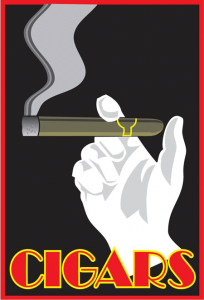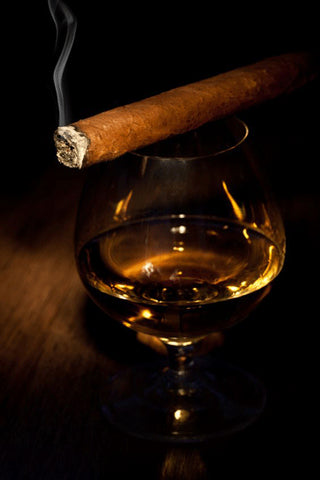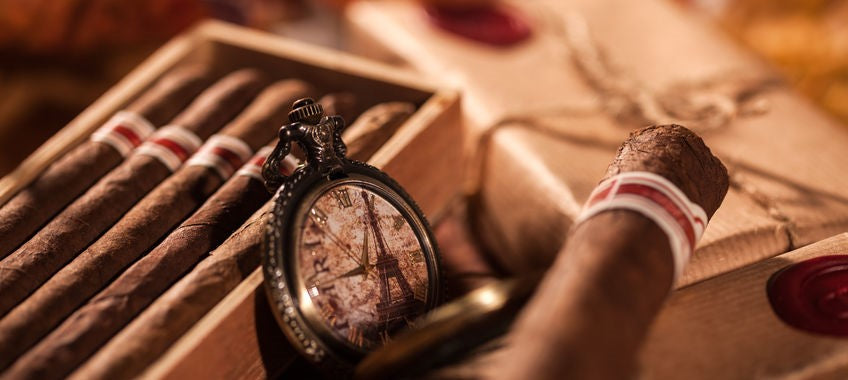What Are ACID Cigars?
Every few years, an industry goes through a shake-up. A new figure emerges with new ideas and new ways of doing things. In the cigar industry, that figure may be Jonathan Drew, founder of Drew Estates and the creator of ACID cigars. Jonathan has taken a maligned, nontraditional cigar type, the flavored cigar, and transformed it into a major seller. When you light up an ACID cigar, instead of the traditional tobacco flavors, you might taste cocoa, honey, citrus, red wine, white pepper, or one of a dozen other sweet or spicy aromas. No two taste alike, but even though millions are sold every year, you won’t find ACID cigars in the pages of Cigar Aficionado. They’re an underground phenomenon; hated by some, beloved by others.
A Quick Overview of Flavored Cigars
There are three ways to make a flavored cigar. The first is to spray the tobacco with syrup, wine, brandy, or extract. The second is to place the cigars in specialized, aromatic rooms or containers where they’re exposed to the flavor extracts and gradually absorb the flavor over time. The third method is to inject the flavors directly into the cigars with a syringe. Because the natural tobacco flavor gets supplanted in the process process, flavored cigars have traditionally been made with low quality tobacco leaves and have been regarded as cheap, second-rate products by cigar lovers and the cigar industry.
Despite its bad reputation, flavoring is quite commonplace among low tier cigar manufacturers, even if few admit to the practice. Most machine rolled cigars require some additional flavoring to enhance the taste of the sho rt, chopped tobacco leaves that go into them. Beer is one of the most common flavors. Liquors, such as whiskey, are another.

Jonathan Drew
Jonathan Drew entered the cigar industry in 1995, when he opened a cigar kiosk in the World Trade Center Mall in New York. He used it as a venue for a Vieja Habana, the private cigar brand he started with his former fraternity brother, Marvin Samuel. La Vieja Habana was initially hand-rolled in a tiny chinchalle on Sixth Avenue, but by 1998 they’d increased production by partnering with Tabacalera Perdomo, garnered good review from Cigar Insider, and scored big with consumers at industry trade shows. Then Hurricane Mitch swept through the Caribbean and devastated tobacco fields in Nicaragua and Honduras, cutting off their tobacco supply.
Teetering on bankruptcy, Jonathan moved to Nicaragua in late 1998 in order to manage cigar production first-hand, leaving his partner Marvin in charge of the company’s US operations. Jonathan lived at the factory and began experimenting with oils, herbs, flowers, and new flavoring methods. The focus on flavored cigars came about because Jonathan felt they were a unique but undervalued tobacco product that would allow him to transform the cigar experience. After a lot of trial and error, ACID launched cigars launched in 1999.
Acid Cigars
The manufacturing process behind ACID cigars is a closely guarded secret, known to only four people on the entire planet. Judging from the final product, its obvious the process is more sophisticated than the flavoring methods used in the past. The biggest hint we’ve been given is the instance by Jonathan and his company, Drew Estate, that ACID cigars are not “flavored cigars” but “infused cigars,” which probably means they’re flavored by absorbing aromas rather than being sprayed with syrup or any other kind of extract. What we do know is that the key to ACID cigars is the finishing stage, where the cigars are wrapped in plastic and left in a cool room for three to eight months so the new flavors permeate the tobacco.
We also know something about the tobacco that goes into ACID cigars. Unlike most cigar companies, which make puros – cigars with tobacco from only one country – Drew Estate makes blended cigars, with tobacco from as many as three to four different countries rolled up into one stick. They check the bales themselves before they’re ship and buy tobacco in bulk, which allows them to sort their leaves according to quality. You’ll find a lot of premium-level tobacco in an ACID cigar. They’re also one of the few flavored cigars rolled by hand instead of by machine. Their draw is tested by weight rather than a draw-testing machine, which Jonathan despises, referring to them as “garbage” and “a virus that must be exterminated.”
What’s not a secret is the impact ACID has had on the industry. Flavored cigars were once thought of as a gateway into the cigar world, only smoked by the new and uninitiated, but Jonathan’s fans range from the young to the old, experienced to inexperienced. Sales of ACID cigars make up approximately 40 percent of Drew’s sales, roughly $12 million a year, and has transformed Drew Estates into major player in the cigar industry and one of the top four or five handmade brands in the United States.
ACID cigars come in four lines and their taste is almost impossible to describe, even for die-hard fans. Over 140 different herbs, oils, and botanical ingredients are used in the production process. No two ACID cigars are ever quite the same, but in general they have a medium body, an easy draw, and produce nice, solid ash. Here’s just a few different types you can enjoy.
| ACID Blue Cigars | Description |
|---|---|
|
Acid Blonde |
Connecticut wrapper. Sweet taste, with
a cream, honey, and citrus undertone.
|
|
Acid Kuba Kuba
|
Sumatra wrapper. Smooth taste, with a
sweet incense aroma.
|
|
Acid Kong Cameroon
|
African wrapper. Red wine taste, with
hints to wood and pine.
|
| ACID Purple Cigars | Description |
|---|---|
|
Acid Roam
|
Churchill Connecticut shade wrapper.
Mild, creamy taste, with floral overtones and a sweet aroma.
|
|
Acid Extra Ordinary Larry
|
Maduro wrapper. Rich coffee and
chocolate taste, with undertones of blackberries and cinnamon and a gardenia scent.
|
|
Acid C-Notes
|
Sumatra wrapper. Sweet, spicy taste.
Medium body and strong smoke due to lose roll.
|
| ACID Gold Cigars | Description |
|---|---|
|
Acid Atom Maduro
|
Dark maduro wrapper. Complex taste of
flowers, tea, roasted cashew, and coffee, with hints of brown sugar and mint.
|
|
Acid Earthiness
|
Cameroon wrapper. Sweet taste that
mellows as you smoke it. Clove and cinnamon undertones.
|
|
Acid Cold Infusion Tea
|
Natural Connecticut wrapper. Strong
tea flavor, with sweet, fruity undertones and a fresh pine aroma.
|
| ACID Red Cigars | Description |
|---|---|
|
Acid Liquid
|
Connecticut wrapper. Strong, slightly
bitter taste, with dark wine, cashew, and floral undertones.
|
|
Acid Nasty
|
Oily maduro wrapper. Pleasant, earthy
flavor, with dark chocolate and floral undertones.
|
ACID cigars are named after Scott “ACID” Chester, one of the artists involved in the DUMBO art festival in the mid-to-late nineties. Jonathan felt Scott’s unique blend of industrial, urban, graffiti, and motorcycle art resonated with the cigar’s unconventional character, which is how he ended up becoming the cigar’s namesake. His silhouette is ACID’s logo.
Storing ACID Cigars
ACID cigars shouldn’t be stored alongside your regular cigars. In fact, they shouldn’t even be stored with one another. Cigars are hygroscopic, which means they absorb moisture from their surroundings and flavors from other cigars. As cigars age, their oils, resins, and sugars seep through the layers of tobacco inside the stick and migrate into the cigars around them, a process known as “marrying.”
Marrying conventional cigars allows them to pick up subtle hints from their neighbors and produce unique, exciting flavors. Marrying conventional cigars with flavored cigars, tends to ruin them. Even high quality flavored cigars like ACID will throw off the carefully crafted bouquet of traditional tobacco, which is why cigar factories separate flavored cigar production from ordinary cigar production, often moving them into separate buildings in order to prevent their conventional cigars from becoming tainted.
The same thing can happen between flavored cigars as well, which is why its recommended you keep your ACID cigars sealed in their original plastic packaging or their cigar box until you’re ready to smoke them. Remember, cigar humidors are designed to absorb moisture too. It’s one of the things that makes them so good at protecting your cigars, but if you’re not careful, the flavors from unwrapped ACID cigars will end up permeating the wood lining of your cigar humidor and throwing off the taste of the conventional cigars you store there afterwards.
Flavored cigars don’t benefit from aging either. Conventional cigars are sometimes aged for years before they’re smoked, but the taste of flavored cigars starts to fade almost as soon as you buy them. They’re meant to be smoked immediately after purchase, so it’s best not to wait more than a few months before lighting them up.

Final Thoughts
When Jonathan Drew created ACID cigars, he wanted to create something new – a rebirth of the cigar. How well he succeeded is still being debated, but their popularity indicates he did pretty well by any standard. ACID cigars are great change-of-pace cigars for experienced smokers, and great opening cigars for beginners.



0 comments